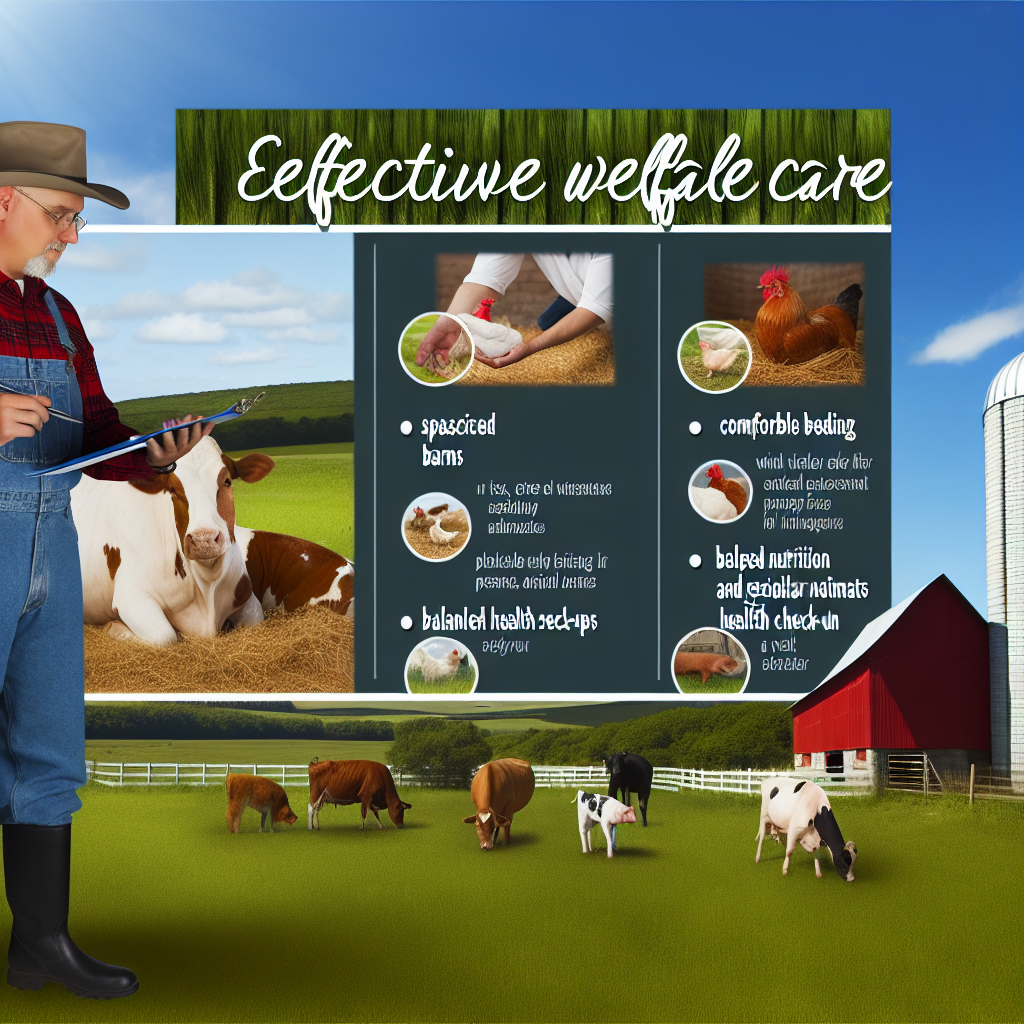Understanding the Importance of Animal Welfare in Farming
The Ethical Responsibility of Farmers
Farmers have a moral obligation to ensure animal welfare.
Caring for animals reflects a commitment to ethical practices.
Moreover, the treatment of animals influences public perception.
Economic Benefits of Animal Welfare
Implementing effective animal welfare policies can enhance profitability.
Healthy animals typically produce better quality products.
Additionally, consumer demand increasingly favors humane treatment.
Investing in animal welfare often leads to lower veterinary costs.
Legal Compliance and Animal Welfare Standards
Regulations regarding animal welfare continue to evolve.
Farmers must stay informed about local and national laws.
Compliance helps avoid penalties and enhances business reputation.
Long-term Sustainability of Farming Practices
Animal welfare is crucial for sustainable farming practices.
Healthy animals contribute to diverse and resilient ecosystems.
This approach aids in maintaining biodiversity on the farm.
Consumer Trends and Animal Welfare
Today’s consumers are increasingly concerned about animal welfare.
They actively seek products from humane and ethical sources.
Transform Your Agribusiness
Unlock your farm's potential with expert advice tailored to your needs. Get actionable steps that drive real results.
Get StartedResponding to these trends can lead to increased market share.
Marketing efforts highlighting animal welfare can strengthen brand loyalty.
Assessing Current Animal Welfare Standards on Your Farm
Evaluating Existing Practices
Start by reviewing your current animal welfare practices.
Document how you care for your animals each day.
Next, compare your practices with industry standards.
Look for any gaps or shortcomings in your methods.
Gathering Input from Stakeholders
Engage with farm staff to understand their views.
They often have invaluable insights about animal welfare.
Additionally, consult with veterinarians for expert opinions.
Consider conducting surveys to gather more detailed feedback.
Tracking Animal Health and Behavior
Observe the health indicators of your livestock.
Regular health checks can help identify issues early.
Monitor how animals interact with each other.
Healthy social interactions often indicate good welfare.
Researching Best Practices
Look into the latest animal welfare research and trends.
Attend workshops or conferences to expand your knowledge.
Networking with other farmers can provide useful tips.
Stay updated with publications from reputable animal welfare organizations.
Documenting Your Findings
Create a comprehensive report of your findings.
Include both strengths and areas needing improvement.
This documentation will guide your future welfare policies.
Regular updates to this report can ensure ongoing improvement.
Key Components of Effective Animal Welfare Policies
Understanding Animal Needs
Every animal has specific physical and behavioral needs.
Meeting these needs is crucial for their overall well-being.
Showcase Your Farming Business
Publish your professional farming services profile on our blog for a one-time fee of $200 and reach a dedicated audience of farmers and agribusiness owners.
Publish Your ProfileFirst, ensure that animals have adequate space to move freely.
Second, provide proper nutrition tailored to their species.
Third, accommodate their social structures and behaviors.
Regular Health Assessments
Regular health assessments help identify potential issues early.
Schedule routine veterinary check-ups for all animals on the farm.
In addition, monitor animals for signs of stress or illness.
Implement an effective vaccination program to prevent disease.
Moreover, maintain clear health records for regular evaluations.
Environmental Enrichment
Environmental enrichment enhances animal welfare significantly.
Provide toys and activities to stimulate natural behaviors.
Additionally, arrange for secure and comfortable sleeping areas.
Moreover, vary their environments to reduce boredom.
Importantly, engage with animals to build trust and reduce anxiety.
Training and Staff Education
Well-trained staff contributes to better animal care.
Provide ongoing education on animal welfare principles.
Encourage staff to participate in workshops and training sessions.
Furthermore, foster a culture of compassion and respect for animals.
Establish clear protocols for handling and caring for animals.
Transparent Policy Development
Engage stakeholders in developing animal welfare policies.
Solicit input from veterinarians, staff, and community members.
Clearly outline goals and standards in your welfare policies.
Additionally, ensure policies are easily accessible to all stakeholders.
Regularly review and update policies to reflect best practices.
Monitoring and Evaluation
Effective monitoring ensures compliance with welfare standards.
Establish metrics to assess animal health and welfare regularly.
Conduct internal audits to evaluate adherence to policies.
Moreover, seek feedback from staff to improve practices.
Lastly, report findings to stakeholders transparently to build trust.
Find Out More: Agricultural Land Use and Zoning Laws
Strategies for Developing Comprehensive Animal Welfare Guidelines
Establish Clear Objectives
Begin by defining clear objectives for your animal welfare policies.
Involve all stakeholders in this process for diverse input.
Be specific about the welfare outcomes you aim to achieve.
Set realistic and measurable goals for your farm.
Conduct Regular Assessments
Perform regular assessments of your current animal welfare practices.
Identify areas for improvement and document any findings.
Utilize tools like animal welfare audits to guide your assessments.
Engage third-party experts for unbiased evaluations.
Implement Training Programs
Develop training programs for all staff on animal welfare standards.
Focus on hands-on training to ensure effective learning.
Incorporate ongoing education to keep staff informed of best practices.
Showcase Your Farming Business
Publish your professional farming services profile on our blog for a one-time fee of $200 and reach a dedicated audience of farmers and agribusiness owners.
Publish Your ProfileMonitor staff performance and provide feedback regularly.
Establish a Reporting System
Create a transparent reporting system for animal welfare concerns.
Encourage staff to openly communicate any issues they encounter.
Ensure that reporting avenues are accessible and confidential.
Regularly review reports and take necessary action.
Engage with the Community
Build relationships with local animal welfare organizations.
Engage the community through outreach programs on animal welfare.
Solicit feedback from community members on your practices.
Use community engagement to enhance transparency and trust.
Review and Revise Policies Regularly
Establish a schedule for reviewing your animal welfare policies.
Revise guidelines based on new research or emerging best practices.
Involve staff in the revision process to foster a sense of ownership.
Share updates with all stakeholders to keep everyone informed.
Discover More: Integrated Pest Management Guidelines
Training Staff on Animal Welfare Best Practices
Importance of Training
Training ensures staff understands animal welfare standards.
Well-informed employees contribute to better animal care.
Additionally, training reduces the risk of animal-related issues.
Developing a Training Program
Begin by identifying key animal welfare principles.
Next, establish clear training objectives for employees.
Include practical demonstrations and hands-on activities.
Finally, create assessment methods to evaluate understanding.
Utilizing Resources
Leverage industry guidelines and research for training content.
Incorporate materials from reputable organizations.
Provide access to online courses or workshops as well.
Continuous Improvement
Schedule regular refresher courses for all staff.
Encourage feedback to improve training effectiveness.
Stay updated on new animal welfare research and practices.
Building a Culture of Welfare
Foster an environment that values animal welfare.
Recognize and reward employees who excel in animal care.
Hold regular discussions about welfare practices and concerns.
Uncover the Details: Food Safety Compliance Strategies for Small Farmers

Monitoring and Evaluating Animal Welfare Outcomes
Establishing Clear Welfare Standards
First, develop clear animal welfare standards for your farm.
These standards should reflect best practices based on scientific research.
Additionally, involve relevant stakeholders in the drafting process.
Feedback from veterinarians, workers, and animal welfare experts is crucial.
Implementing Regular Monitoring Procedures
Next, implement regular monitoring procedures to assess compliance.
Use standardized checklists to evaluate animal health and welfare.
Conduct assessments on a routine basis to gather consistent data.
Moreover, document findings for transparency and accountability.
Utilizing Technology for Data Collection
Technology can enhance the monitoring process significantly.
Showcase Your Farming Business
Publish your professional farming services profile on our blog for a one-time fee of $200 and reach a dedicated audience of farmers and agribusiness owners.
Publish Your ProfileConsider using video surveillance to observe animal behavior.
Wearable devices can provide real-time health data on livestock.
These innovations allow for early detection of welfare issues.
Engaging Staff in Welfare Practices
Training staff is fundamental to successful welfare implementation.
Provide workshops that cover best practices and monitoring techniques.
Encourage staff to report concerns regarding animal welfare promptly.
Engaged staff can identify issues early, leading to timely interventions.
Evaluating Outcomes and Making Improvements
Finally, regularly evaluate the outcomes of animal welfare initiatives.
Use data to inform decisions and improve welfare practices continuously.
Set specific goals for animal health and welfare to measure success.
Adjust strategies based on results to optimize animal care.
Uncover the Details: Common Misconceptions About Agricultural Insurance Policies
Incorporating Technology to Enhance Animal Welfare
Understanding the Role of Technology
Technology plays a vital role in improving animal welfare on farms.
It allows farmers to monitor animal health more effectively.
Moreover, technology enhances livestock living conditions.
Farmers can harness various tools to increase efficiency.
Thus, investing in technology offers numerous benefits.
Implementing Monitoring Systems
One effective method is to use monitoring systems.
These systems track animal behavior and health metrics.
Examples include wearable sensors that provide real-time data.
Such devices alert farmers to potential health issues.
Consequently, farmers can respond rapidly to animal needs.
Utilizing Automation Tools
Automation tools can enhance daily farm operations.
For instance, automated feeding systems ensure proper nutrition.
These systems can be programmed to suit specific requirements.
Additionally, they reduce human error in animal care.
As a result, animals receive consistent and adequate feed.
Engaging in Data Analysis
Data analysis is crucial for improving animal welfare.
Farmers can collect and analyze information to identify trends.
This data helps in making informed decisions about care.
Furthermore, analytics can reveal areas for improvement.
Consequently, farms can adapt to changing animal needs.
Leveraging Communication Technologies
Communication technologies streamline operations on farms.
Farmers can connect with veterinarians and advisers remotely.
This access allows for prompt consultations and assessments.
Furthermore, online platforms offer training resources for staff.
In turn, this knowledge enhances overall animal care practices.
Enhancing Environmental Conditions
Technology also improves environmental conditions for animals.
Farmers can use climate control systems to maintain optimal temperatures.
Additionally, air quality monitoring ensures healthier environments.
Showcase Your Farming Business
Publish your professional farming services profile on our blog for a one-time fee of $200 and reach a dedicated audience of farmers and agribusiness owners.
Publish Your ProfileThese conditions contribute to the well-being of livestock.
Ultimately, comfortable animals lead to better productivity.
Engaging with Stakeholders and the Community on Animal Welfare Issues
Building Relationships with Stakeholders
Effective animal welfare policies begin with strong relationships.
Farmers must identify their key stakeholders.
These include suppliers, local veterinarians, and animal welfare groups.
Engage in open communication with these stakeholders.
Regular meetings create transparency and trust.
Moreover, share your commitment to animal welfare openly.
Involving the Community
Community involvement is crucial for successful animal welfare initiatives.
Host community events to raise awareness about animal welfare.
These events can include farm tours or educational workshops.
Encourage feedback from community members during these events.
Listening to their concerns fosters a strong relationship.
Developing Partnerships
Forming partnerships with local organizations is beneficial.
Collaborate with nonprofits focused on animal welfare.
Consider joining forces with universities for research opportunities.
These partnerships can provide resources and expertise.
Additionally, they can enhance the credibility of your farm’s practices.
Utilizing Social Media and Technology
In today’s digital age, social media plays a vital role.
Use social platforms to share success stories related to animal welfare.
Engage your audience with captivating content and visuals.
Seek input from followers to create a sense of community.
Furthermore, leverage technology to track and report animal welfare metrics.
Monitoring and Assessment
Continuous evaluation of animal welfare practices is essential.
Develop assessment tools to measure the effectiveness of your policies.
Involve stakeholders in this monitoring process.
Their insights can aid in adjusting strategies for improvement.
Be open to making changes based on feedback received.
Creating Educational Opportunities
Education plays a significant role in enhancing animal welfare.
Offer workshops focused on best practices in animal care.
Host sessions on the ethical treatment of livestock.
Collaborate with experts to ensure accurate information is shared.
These educational opportunities can empower both farm workers and the community.
Additional Resources
Animal Policy & Regulatory Issues | Economic Research Service




